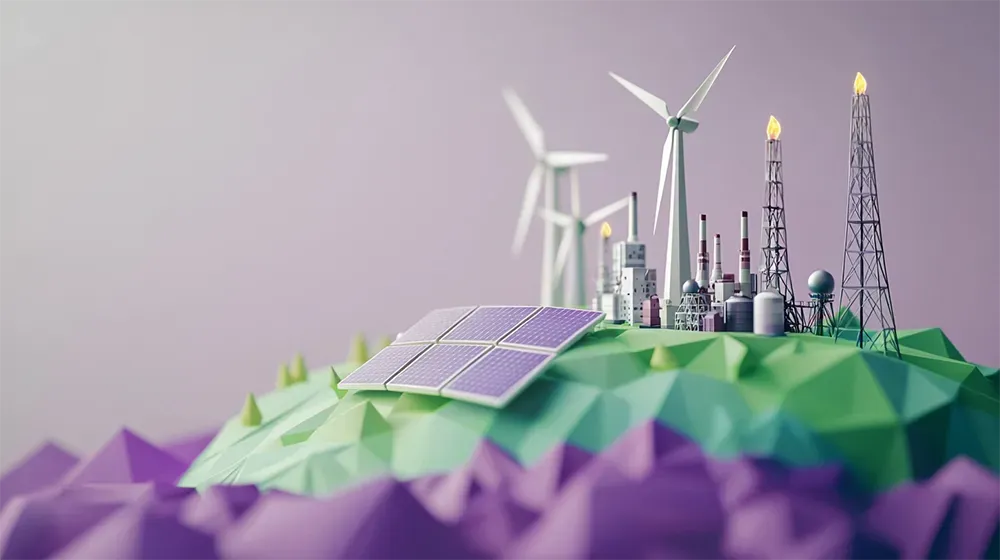Understanding Edge Computing with a Futurist Keynote Speaker

Understanding Edge Computing with a Futurist Keynote Speaker
In today's technology-driven world, where data and connectivity are central to our daily lives, the concept of edge computing has become increasingly important. But what exactly is edge computing, and how can it revolutionize the way we operate in the digital realm? In this article, we will delve into the intricacies of edge computing and explore its potential impacts and benefits. But first, let's start by understanding the concept itself.
Understanding the Concept of Edge Computing
Edge computing can be thought of as a decentralized approach to data processing and storage. Unlike traditional cloud computing, where data is processed in centralized data centers, edge computing brings computation closer to the source of the data, at the "edge" of the network. This means that data is processed and analyzed locally, on the devices or servers nearest to where it is generated, rather than being sent to a distant data center.
By moving computation closer to the source, edge computing offers several advantages. First and foremost, it drastically reduces latency, as data doesn't need to travel across long distances to reach the processing center. This is particularly crucial for applications that require real-time processing, such as autonomous vehicles or live video streaming. In addition, edge computing enhances security by minimizing data exposure and potential vulnerabilities associated with transmitting sensitive information to the cloud.
Another key benefit of edge computing is its ability to handle vast amounts of data. With the proliferation of Internet of Things (IoT) devices, which generate massive volumes of data, edge computing provides a scalable solution by distributing the processing load across a network of edge nodes. This not only ensures efficient data management but also eliminates the need for sending large amounts of data to centralized servers, reducing bandwidth requirements and related costs.
But how can we make sense of such a complex concept? This is where a futurist keynote speaker can play a crucial role.
Imagine attending a conference where a renowned futurist keynote speaker takes the stage to explain the intricacies of edge computing. The speaker, armed with years of experience and expertise, captivates the audience with engaging anecdotes and real-world examples.
The speaker begins by delving into the history of computing, tracing its evolution from the mainframe era to the advent of cloud computing. They highlight the limitations of centralized data processing and storage, emphasizing the need for a more distributed approach in the face of increasing data volumes and the demand for real-time processing.
As the audience listens intently, the speaker introduces the concept of edge computing, painting a vivid picture of a network where data flows seamlessly between devices, servers, and edge nodes. They explain how edge computing enables devices to make autonomous decisions, reducing the reliance on constant connectivity and minimizing the impact of network latency.
The speaker then dives into the technical aspects of edge computing, discussing the architecture and components that make it possible. They explore the role of edge nodes, which act as local processing hubs, and highlight the importance of edge analytics in extracting valuable insights from data at the edge.
Throughout the keynote, the speaker peppers their talk with real-world examples of edge computing in action. They discuss how edge computing powers smart cities, enabling efficient traffic management, intelligent energy distribution, and enhanced public safety. They also touch upon the role of edge computing in industries such as healthcare, where real-time data analysis can save lives by enabling faster diagnosis and treatment.
As the keynote draws to a close, the speaker leaves the audience with a sense of excitement and possibility. They emphasize the transformative potential of edge computing, envisioning a future where devices seamlessly collaborate, making intelligent decisions at the edge, and unlocking new possibilities across industries.
So, the next time you come across the term "edge computing," remember the captivating keynote speaker who brought this complex concept to life. Their insights and expertise shed light on the power and potential of edge computing, leaving you inspired and eager to explore the possibilities that lie at the edge of the network.
The Role of a Futurist Keynote Speaker in Simplifying Edge Computing
A futurist keynote speaker possesses a unique ability to distill complex technological concepts into a language that is not only comprehensible but also relatable to a wide range of audiences. Their expertise lies in thoroughly researching and analyzing emerging technologies, such as edge computing, and presenting their findings in an engaging and accessible manner.
Edge computing, the decentralized processing of data at the edge of the network, holds immense potential for transforming industries across the board. However, understanding its intricacies and implications can be a daunting task for many organizations. This is where a futurist keynote speaker steps in, armed with a wealth of knowledge and the ability to make the complex seem simple.
By utilizing real-world examples and industry insights, a futurist keynote speaker can help organizations understand how edge computing can be applied to their specific business needs. They can highlight the potential advantages and challenges of implementing edge computing and provide actionable strategies for integrating it into their existing infrastructure.
Imagine a healthcare organization grappling with the need to process vast amounts of patient data in real-time. A futurist keynote speaker can demonstrate how edge computing can enable them to analyze this data at the point of collection, reducing latency and improving patient outcomes. They can delve into the technical aspects of edge computing, explaining concepts such as edge devices, edge analytics, and edge security in a way that resonates with the audience.
Furthermore, a futurist keynote speaker can assist in navigating the potential implications of edge computing on various industries. From healthcare and manufacturing to transportation and finance, the impact of edge computing is far-reaching. By shedding light on these implications, a futurist keynote speaker empowers businesses to make informed decisions and adapt to the changing technological landscape.
Consider a manufacturing company seeking to optimize its production processes. A futurist keynote speaker can illustrate how edge computing can enable real-time monitoring and analysis of machine data, leading to predictive maintenance and increased operational efficiency. They can discuss the potential challenges of implementing edge computing in a manufacturing setting, such as connectivity issues and data security concerns, and offer practical solutions to overcome these obstacles.
In the realm of transportation, a futurist keynote speaker can delve into the world of autonomous vehicles and the role of edge computing in enabling real-time decision-making at the edge. They can explore how edge computing can enhance the safety and efficiency of transportation systems, from traffic management to fleet optimization. By providing insights into the potential benefits and challenges of implementing edge computing in the transportation sector, a futurist keynote speaker equips organizations with the knowledge needed to embrace this transformative technology.
As the digital landscape continues to evolve at a rapid pace, staying ahead of the curve becomes increasingly crucial for businesses. A futurist keynote speaker serves as a guide, helping organizations navigate the complex world of edge computing and harness its potential. By simplifying complex concepts, providing real-world examples, and highlighting industry implications, they empower businesses to make informed decisions and embrace the future with confidence.
The Potential Impacts and Benefits of Edge Computing
As we continue to embrace the digital age, the potential impacts and benefits of edge computing cannot be overstated. Let's delve into some of the key advantages that this paradigm shift can offer:
- Improved Efficiency: Edge computing reduces the time it takes for data to travel from its origin to the processing center, resulting in faster response times and improved operational efficiency.
- Enhanced Reliability: By distributing the processing load across multiple edge nodes, edge computing reduces the risk of network congestion or single point failures, ensuring a more reliable and resilient computing infrastructure.
- Cost Savings: With edge computing, businesses can reduce their bandwidth requirements and cloud storage costs by processing and storing data locally. This can lead to significant cost savings over time.
- Data Privacy and Security: Edge computing minimizes the need to transmit sensitive data to the cloud, thus reducing the risk of data breaches or unauthorized access. This is particularly vital for industries handling sensitive customer information, such as healthcare and finance.
While the potential impacts and benefits are evident, it is essential to consider the insights from a futurist keynote speaker to truly grasp the future of edge computing.
Insights from a Futurist Keynote Speaker: The Future of Edge Computing
A futurist keynote speaker can provide valuable insights into the future of edge computing. By analyzing emerging trends, technological advancements, and industry developments, they can offer a glimpse into how edge computing is likely to shape our world in the years to come.
One exciting area where edge computing is poised to make a significant impact is the Internet of Things (IoT). As more devices become interconnected, the demand for localized processing and real-time analytics will continue to grow. Edge computing can provide the necessary infrastructure to transform the vast amounts of data generated by IoT devices into actionable insights, paving the way for smarter cities, more efficient manufacturing processes, and improved healthcare systems.
In addition to IoT, edge computing is also expected to play a vital role in the development of technologies such as autonomous vehicles and augmented reality (AR). By enabling real-time decision-making and reducing latency, edge computing can make these technologies more reliable and immersive, ultimately enhancing user experiences and opening up new possibilities.
Implementing Edge Computing in Your Business Strategy
Now that we have a deeper understanding of edge computing's concept, its potential impacts, and insights from a futurist keynote speaker, it's time to consider how to incorporate edge computing into your business strategy. Here are a few steps to get you started:
- Educate your team: Ensure that all stakeholders within your organization have a solid understanding of edge computing and its implications.
- Identify use cases: Assess the areas within your business operations that could benefit from edge computing, such as real-time analytics, video processing, or IoT data management.
- Conduct a feasibility study: Evaluate the technical requirements and potential challenges associated with implementing edge computing in your infrastructure.
- Collaborate with industry partners: Engage with technology providers and experts in the field to leverage their expertise and ensure a successful implementation.
- Continuously monitor and adapt: As edge computing technology evolves, it is essential to stay informed and adapt your strategy accordingly to maximize its potential benefits.
With the guidance and insights of a futurist keynote speaker, you can navigate the complexities of edge computing and leverage its potential to drive innovation and growth within your organization. Embrace the power of edge computing and unlock a world of possibilities in the digital realm.
FAQ
1. What is edge computing?
Edge computing is a decentralized approach to data processing and storage that brings computation closer to the source of the data, at the "edge" of the network. It involves processing and analyzing data locally on devices or servers nearest to where it is generated, rather than sending it to a distant data center.
2. What are the benefits of edge computing?
Edge computing offers several benefits, including reduced latency, enhanced security, and the ability to handle vast amounts of data. By processing data closer to the source, it reduces the time it takes for data to travel, improves real-time processing capabilities, and minimizes the risk of data exposure. It also enables efficient data management and reduces bandwidth requirements and costs.
3. How can a futurist keynote speaker help in understanding edge computing?
A futurist keynote speaker can simplify the complex concept of edge computing by providing real-world examples and industry insights. They can explain the technical aspects, discuss the implications for various industries, and offer actionable strategies for integrating edge computing into existing infrastructure. Their expertise and ability to make complex concepts relatable can help organizations understand and embrace the potential of edge computing.
Contact a Futurist Keynote Speaker for Your Event
Having delved into the fascinating world of edge computing, wouldn't you want to bring such insights and expertise to your next event? Dr Mark van Rijmenam, a renowned Futurist Keynote Speaker, can make this possible. With his wealth of knowledge and captivating delivery, Dr van Rijmenam will not only demystify complex concepts like edge computing but will also provide practical strategies for your organization to harness its potential. He will engage your audience with real-world examples, industry insights, and a glimpse into the future of digital transformation. Ready to take your event to the next level? Simply complete the form below and we will be in touch within 24 hours to discuss how Dr van Rijmenam can make your event a memorable one.
Thanks for your inquiry
We have sent you a copy of your request and we will be in touch within 24 hours on business days.
If you do not receive an email from us by then, please check your spam mailbox and whitelist email addresses from @thedigitalspeaker.com.
In the meantime, feel free to learn more about The Digital Speaker here.
Or read The Digital Speaker's latest articles here.





